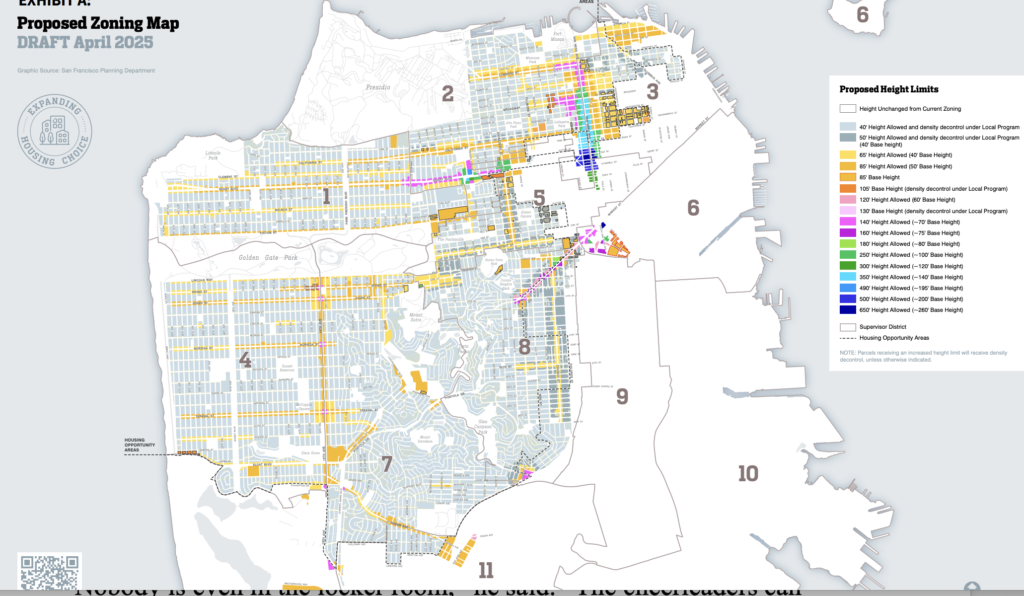The Planning Department has been working since London Breed was mayor on a plan to increase density and height limits on the West Side, but now it’s Mayor Daniel Lurie’s plan, since he’s in office and has endorsed it.
The Chron, of course, loves it. The people who used to build small projects on the West Side of town think it’s pointless:
Residential Builders Association President Sean Keighran said the rezoning wouldn’t generate housing in the foreseeable future.
“San Francisco does not have a zoning problem,” Keighran said. “The builders of San Francisco have economic problems, and zoning will not fix it.”
He said most RBA members, who were responsible for thousands of units completed from 2000 to 2015, are “building in other jurisdictions” and are not even paying attention to the rezoning debates.
“Nobody is even in the locker room,” he said. “The cheerleaders can practice their cheers and one day it will be important, but right now they are just cheerleaders practicing. It’s not going to lead to housing.”
At least, the small local folks aren’t building.
What we might see instead is widespread speculation: Although the Yimbys say that people in less-dense neighborhoods worry about their property values declining, the reality is that in much of the area on the new map, upzoning will mean significant increases in property value.

A single-family lot with one house on it might be worth $1.5 million. Let a builder put four units on that site and suddenly it’s worth at least double that. Take a 40-foot-tall building with three stories, double the height, and its value takes off.
In both cases, the existing buildings will be demolished. Not so big a deal if owner-occupied houses are sold, and several families are able to buy the new units and move in; parking will be an issue, but parking is always an issue on the West Side.
If current trends in the housing market continue, though, what may happen is that one of the big national firms that are buying up single-family housing all over the country will come in, turn one unit into four, and make them all expensive rentals, which by law won’t be under rent control.
From the Race and Equity in All Planning Coalition:
Help us save local journalism!
Every tax-deductible donation helps us grow to cover the issues that mean the most to our community. Become a 48 Hills Hero and support the only daily progressive news source in the Bay Area.
The upzoning proposal does not meet our desperate housing needs, especially for truly affordable
housing and family-sized housing. By escalating land values through upzoning and
incentivizing developers to take advantage of density decontrol, which only serves to increase
the profits of the real estate industry, the City is making housing more expensive for all
residents, small businesses, and affordable housing developmen
Meanwhile, along the commercial corridors like Geary and Clement, Haight and Divisadero, the increased heights will apply to buildings that already have rent-controlled tenants and small businesses. The law says if a rent-controlled building is demolished, the new building also has to be under rent control, and the existing tenants get to move back.
That hardly ever happens. Demolition and new construction, even with no permit issues, is going to take a year or more. Those tenants will find new places or leave town; nobody will ever make an effort to find them, help them move back, or enforce the laws. The developer will not, for example, have to find them new apartments at similar (or subsidized) rent, pay moving expenses, and stay in touch with them to let them know the new unit is ready.
Commercial tenants, almost all of them small independent businesses, will get nothing: California doesn’t allow commercial rent control or commercial displacement protections. A small community-serving business that is displaced for new construction will likely never come back.
The new buildings will be expensive to construct, for reasons that have nothing to do with “constraints” or zoning and everything to do with interest rates and construction costs (which will go higher thanks to tariffs, and even higher if mass deportations devastate the construction labor pool). Commercial rents will price out most existing tenants, changing the essential fabric of the neighborhoods.
These things could be fixed: The state, as part of its demands for more housing development, could allow cities to impose commercial rent control and a right for small businesses to return at the old rent. The Legislature could allow cities to tighten the protection for existing renters.
Those tools have never been a part of the Yimby discussion in Sacramento; they get dismissed as “raising the cost” of new construction, thus discouraging more market-rate housing—which the evidence shows doesn’t bring down costs anyway.
If this plan succeeds, and bulldozers start arriving in the Richmond and the Sunset, Lurie is going to find that some of his strongest supporters are very unhappy.
The Planning Commission will hold an informational hearing on the plan Thursday/10. The question that the commissioners need to ask is a difficult one: Can a city like San Francisco, in today’s neoliberal capitalist system, increase density for market-rate developers without destroying existing vulnerable communities? I think the answer is yes—but not until the state gives cities the tools to protect those communities and the money for adequate affordable housing. Which is not part of the Scott Wiener-Gavin Newsom (and now Daniel Lurie) agenda. If that doesn’t change, the answer is clearly no and the upzoning will be either a waste of everyone’s time (because nothing gets built) or a total disaster because residential and commercial tenants are displaced by speculators. Not a good choice.
The hearing starts at noon.
Sup. Shamann Walton is holding a hearing on
the treatment of residents at Alice Griffith Housing by McCormack Baron Salazar and the quality of services provided, mistreatment of residents, and oversight responsibilities.
The public housing project is in Hunters Point, and residents have complained about the way property managers have operated. For decades, the city’s Housing Authority managed this and other properties, often badly. In an effort at reform, they’ve been turned over to outside managers with experience in the affordable housing field.
Everyone involved, including affordable housers, agreed it was an experiment; could a private company or nonprofit organization do a better job than the city?
The hearing, at the Rules Committee Monday/7, will shed some light. It starts at 10am.




